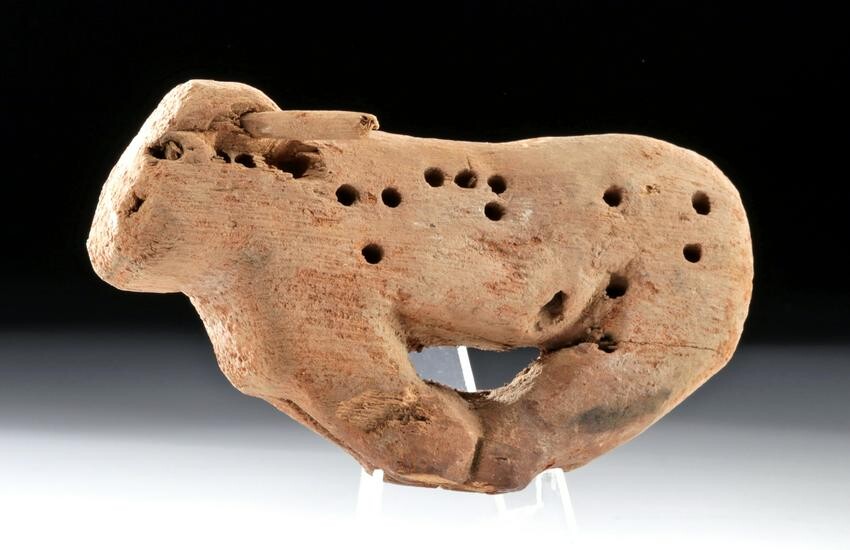Egyptian Wood Votive Figure - Trussed Ox
**Originally Listed At $550**
Ancient Egypt, Third Intermediate to Late Dynastic Period, 21st to 31st Dynasty, ca. 1070 to 332 BCE. A hand-carved votive sculpture depicting a trussed ox with forelegs and hind legs bound together. The animal is defined by its bulbous body, wide snout, and powerful legs. The body has several drilled mortises that were perhaps used for depositing smaller offerings. Figures depicting bound oxen represent food and sustenance for a deceased individual during their journey through the afterlife. The survival of this ancient wooden sculpture suggests this was entombed with the deceased upon burial. Size: 4.1" L x 2.3" H (10.4 cm x 5.8 cm)
For a stylistically similar example of a trussed ox formed from glass, please see The Museum of Fine Arts, Boston, accession number 72.1296.
Provenance: private J.H. collection, Beaverton, Oregon, USA, acquired in 2016; ex-Helios Gallery, Wiltshire, England; ex-private Steinberg collection, Zurich, Switzerland, acquired in London during the 1960s to 1970s
All items legal to buy/sell under U.S. Statute covering cultural patrimony Code 2600, CHAPTER 14, and are guaranteed to be as described or your money back.
A Certificate of Authenticity will accompany all winning bids.
We ship worldwide to most countries and handle all shipping in-house for your convenience.
#151265
Condition Report: Minor abrasions and fissures to body, legs, and head, with nicks to some carved areas, and light encrustations within some drilled holes. Great earthen deposits and nice patina throughout.
View it on
Estimate
Time, Location
Auction House
**Originally Listed At $550**
Ancient Egypt, Third Intermediate to Late Dynastic Period, 21st to 31st Dynasty, ca. 1070 to 332 BCE. A hand-carved votive sculpture depicting a trussed ox with forelegs and hind legs bound together. The animal is defined by its bulbous body, wide snout, and powerful legs. The body has several drilled mortises that were perhaps used for depositing smaller offerings. Figures depicting bound oxen represent food and sustenance for a deceased individual during their journey through the afterlife. The survival of this ancient wooden sculpture suggests this was entombed with the deceased upon burial. Size: 4.1" L x 2.3" H (10.4 cm x 5.8 cm)
For a stylistically similar example of a trussed ox formed from glass, please see The Museum of Fine Arts, Boston, accession number 72.1296.
Provenance: private J.H. collection, Beaverton, Oregon, USA, acquired in 2016; ex-Helios Gallery, Wiltshire, England; ex-private Steinberg collection, Zurich, Switzerland, acquired in London during the 1960s to 1970s
All items legal to buy/sell under U.S. Statute covering cultural patrimony Code 2600, CHAPTER 14, and are guaranteed to be as described or your money back.
A Certificate of Authenticity will accompany all winning bids.
We ship worldwide to most countries and handle all shipping in-house for your convenience.
#151265
Condition Report: Minor abrasions and fissures to body, legs, and head, with nicks to some carved areas, and light encrustations within some drilled holes. Great earthen deposits and nice patina throughout.



